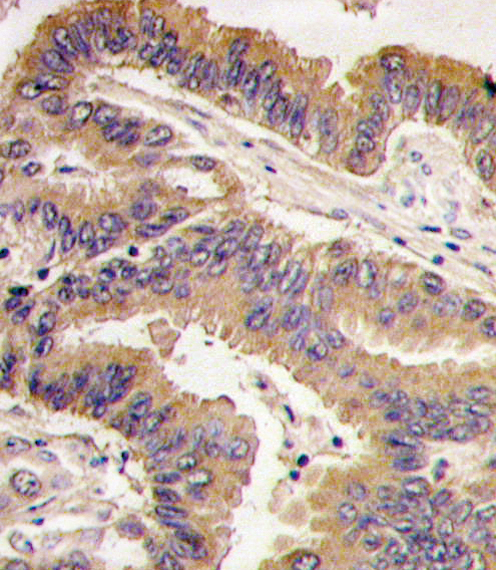

| WB | 咨询技术 | Human,Mouse,Rat |
| IF | 咨询技术 | Human,Mouse,Rat |
| IHC | 1/100-1/500 | Human,Mouse,Rat |
| ICC | 技术咨询 | Human,Mouse,Rat |
| FCM | 咨询技术 | Human,Mouse,Rat |
| Elisa | 咨询技术 | Human,Mouse,Rat |
| Aliases | Growth/differentiation factor 5, GDF-5, Bone morphogenetic protein 14, BMP-14, Cartilage-derived morphogenetic protein 1, CDMP-1, Lipopolysaccharide-associated protein 4, LAP-4, LPS-associated protein 4, Radotermin, GDF5, BMP14, CDMP1 |
| Entrez GeneID | 8200 |
| WB Predicted band size | 55.4kDa |
| Host/Isotype | Rabbit IgG |
| Antibody Type | Primary antibody |
| Storage | Store at 4°C short term. Aliquot and store at -20°C long term. Avoid freeze/thaw cycles. |
| Species Reactivity | Human |
| Immunogen | This GDF5 antibody is generated from rabbits immunized with a KLH conjugated synthetic peptide between 13-41 amino acids from the N-terminal region of human GDF5. |
| Formulation | Purified antibody in PBS with 0.05% sodium azide,1%BSA and 50% glycerol.prepared by Saturated Ammonium Sulfate (SAS) . |
+ +
以下是关于GDF5 (N-term)抗体的3篇参考文献示例,包含文献名称、作者及摘要概括:
---
1. **文献名称**: *"Characterization of a Novel GDF5 (N-terminal) Antibody in Cartilage Development Studies"*
**作者**: Hogan BLM, et al.
**摘要**: 本研究通过生成并验证一种针对GDF5蛋白N末端区域的多克隆抗体,探究GDF5在小鼠胚胎肢体发育中的作用。Western blot和免疫组化结果显示,该抗体特异性识别GDF5前体蛋白及成熟形式,并证实GDF5在关节软骨形成中的时空表达模式,为骨骼发育机制提供了新见解。
2. **文献名称**: *"GDF5 Expression in Osteoarthritis: Detection Using an N-terminal Specific Antibody"*
**作者**: Miyamoto Y, et al.
**摘要**: 研究利用抗GDF5 (N-term)单克隆抗体分析骨关节炎患者滑膜组织中的GDF5表达。通过免疫组织化学和ELISA检测,发现疾病晚期患者GDF5蛋白水平显著降低,提示其与软骨退行性变的潜在关联,为治疗靶点开发提供依据。
3. **文献名称**: *"Validation of GDF5 Antibody Specificity for Western Blot and Immunoprecipitation"*
**作者**: Sengle G, et al.
**摘要**: 该文献系统验证了多种GDF5抗体(包括N-term表位)的特异性。通过敲除细胞模型和竞争性肽段阻断实验,证明所开发的兔源GDF5 (N-term)抗体适用于蛋白免疫印迹和免疫沉淀,且不与TGF-β家族其他成员发生交叉反应,为相关研究提供了可靠工具。
---
这些文献涵盖了抗体开发、疾病机制及实验验证方向,均涉及GDF5 (N-term)抗体的应用与功能分析。实际引用时建议通过学术数据库核实具体文章信息。
The GDF5 (N-term) antibody is designed to detect the N-terminal region of Growth Differentiation Factor 5 (GDF5), a member of the transforming growth factor-beta (TGF-β) superfamily. GDF5. also known as cartilage-derived morphogenetic protein-1 (CDMP-1), plays a critical role in skeletal and joint development, particularly in chondrogenesis, limb patterning, and cartilage maintenance. It signals through bone morphogenetic protein (BMP) receptors, activating Smad-dependent pathways to regulate cell differentiation and tissue morphogenesis. Mutations in the GDF5 gene are linked to skeletal disorders like brachydactyly, chondrodysplasias, and osteoarthritis, underscoring its clinical relevance.
The antibody specifically targets epitopes in the N-terminal prodomain or mature domain of GDF5. enabling the detection of precursor or processed forms in various applications, including Western blotting, immunohistochemistry, and ELISA. It is commonly used in research to study GDF5 expression in developing tissues, cartilage repair mechanisms, and degenerative joint diseases. Validation typically involves testing on recombinant GDF5 or cell lysates from GDF5-expressing systems to confirm specificity and minimize cross-reactivity with related TGF-β family members. Researchers also employ it to explore therapeutic strategies for cartilage regeneration or to model genetic skeletal abnormalities. Its utility extends to both basic developmental biology and translational studies targeting musculoskeletal disorders.
×